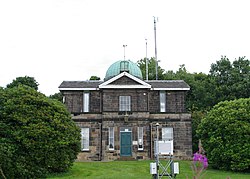| Durham Observatory | |
|---|---|
 Observatory front view | |
| General information | |
| Type | Observatory |
| Location | Potters Bank, Durham |
| Coordinates | 54°46′05″N1°35′10″W / 54.768°N 1.586°W |
| Construction started | 1839 |
| Completed | 1841 |
| Owner | Durham University |
| Design and construction | |
| Architect(s) | Anthony Salvin |
| Website | |
| durhamweather | |
The Durham University Observatory is a weather observatory owned and operated by the University of Durham. It is a Grade II listed building [1] located at Potters Bank, Durham and was founded in 1839 initially as an astronomical and meteorological observatory (owing to the need to calculate refraction from the air temperature) by Temple Chevallier, until 1937 when the observatory moved purely to meteorological recording. [2]
Contents
The observatory's current director is Professor Tim Burt of the Geography Department, who is also Master of Hatfield College.
After the Radcliffe Observatory in Oxford (from 1772) and the Armagh Observatory (from 1795), Durham has the third longest unbroken meteorological record in the UK, with records dating back to 23 July 1843, [3] principally due to the work of Gordon Manley in creating a temperature record that would be comparable to Oxford's. [4] In 2022, Oxford University Press published Durham Weather and Climate since 1841, analysing the observatory's weather records and giving a history of the observations, as a sister volume to their Oxford Weather and Climate since 1767 (2019). [5] Observations were made manually until 1999, since when a Met Office automatic weather station has been used. [3]
The observatory is a World Meteorological Organization Centennial Observing Station. [6]

